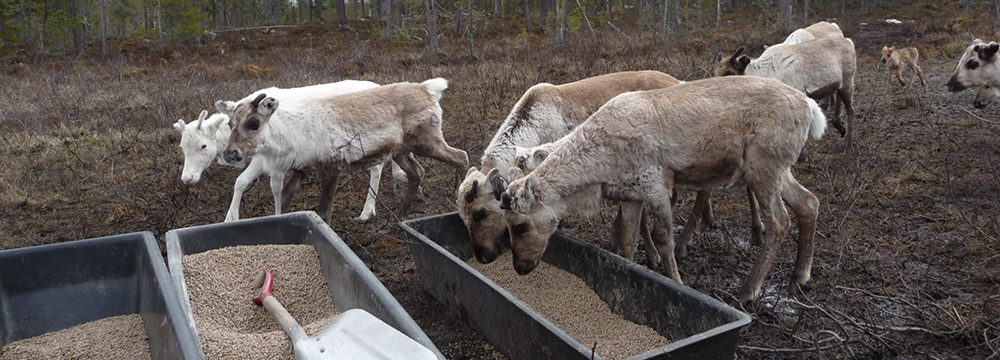Alessia Uboni
Presentation

Current position:
Postdoctoral researcher, funded by a personal 4-year mobility grant awarded by the Swedish Research Council Formas
Preamble – Short summary about interest/focus
I am a wildlife ecologist currently exploring the responses to predation and anthropogenic disturbances of semi-domesticated reindeer, from a behavioral and ecological point of view.
Throughout my academic career, I have worked on a wide range of topics and systems. I started with exploring technical aspects of the analysis of animal home ranges using radiotelemetry. Then, I moved to the study of host-parasite systems, insect physiology, and behavior. Later, I explored temporal variability in the habitat selection patterns of a top-predator, and lastly I investigated the responses of a pastoral system to losses of food resources. In my current project, I investigate the processes that link human activities and predators to the most influential herbivore of arctic and subarctic ecosystems, the reindeer, and how the impact of those processes cascades down to reindeer food resources.
Research
Current research
- Non-lethal consequences of a landscape of fear. In many parts of the world, pastoral systems are facing increasing challenges due to the expansion of predator populations and the raising anthropogenic need for natural resources. As other land uses expand, the land available for herders to keep their herds shrinks. As a consequence, semi-domesticated animals that rely on natural food resources are faced with challenges due to the need to balance the search for suitable habitat with the avoidance of predators. My project aims at exploring the challenges and consequences of these process, using reindeer husbandry in northern Sweden as the model system. In the last century, reindeer husbandry has been facing losses of suitable winter pastures due to the expansion of other land uses and the increase frequency of adverse winters, and at the same time an increase in predation pressure due to the recovery of several predator populations. All of these factors together challenge the persistence of reindeer husbandry. Due to the high ecological and cultural importance of reindeer in the subarctic and Arctic, understanding those challenges and finding solutions to minimize the impacts are high priorities. In my project, I aim to determine how human activities and biotic stressors (such as predation and insect harassment) interact in affecting reindeer movement and space use.
- Toward a holistic understanding of lichen growth: linkages among reindeer, lichens, moose, and forestry. Lichens play an essential role in boreal forests. They are important contributors to the carbon, water, and nutrient cycles, as well as fundamental winter food resources for an economically and ecologically important herbivore, the reindeer. Despite the essential role that lichens play in boreal forests, in Sweden their coverage has drastically decreased in the last decades and our understanding of the factors that regulate their growth is still limited. Such information is crucial to predict how future environmental changes will affect lichens, ecosystem functioning, and reindeer survival. In this project, I aim to assess whether moose winter browsing on pine trees indirectly affect lichen growth through an increase in light availability.
Background
Education and degree
2005, B.Sc. in Biology, University of Trieste, Italy
2007, M.Sc. in Wildlife Conservation and Biodiversity, University of Turin, Italy
2012, Ph.D. in Forest Science, with focus on wildlife ecology, Michigan Technological University, USA
Positions
2016-present Postdoctoral Researcher, Swedish University of Agricultural Sciences, Sweden
2017-2019 Guest Researcher, University of Oslo, Norway
2013-2015 Postdoctoral Researcher, Umeå University, Sweden
2009-2012 Graduate Research Assistant, Michigan Technological University, USA
2008 Geographic Information System (GIS) Intern, Spatial Analysis Center, Yellowstone National Park, USA
Selected publications
-
Valente S, Skarin A, Ciucci P & Uboni A. 2020. Attacked from two fronts: Interactive effects of anthropogenic and biotic disturbances generate complex movement patterns. Arctic, Antarctic, and Alpine Research 52 (1): 27-40
-
Uboni A, Blochel A, Kodnik D & Moen J. 2019. Modelling occurrence and status of mat-forming lichens in boreal forests to assess the past and current quality of reindeer winter pastures. Ecological Indicators 96: 99-106
- Uboni A, Smith DW, Stahler DR & Vucetich JA. 2017. Selecting habitat to what purpose? The advantage of exploring the habitat-fitness relationship. Ecosphere 8(4): e01705
-
Uboni A, Horstkotte T, Kaarlejärvi E, Sévêque A, Stammler F, Olofsson J, Forbes BC & Moen J. 2016. Long-term population dynamics of Eurasian reindeer: trends, synchrony, and the role of large-scale climate. PlosOne 11(6): e0158359.
- Uboni A, Vucetich JA, Stahler DR & Smith DW. 2015. Interannual variability: a crucial component of space use at the territory level. Ecology 96(1): 62-70.
Links
See all publications at Google Scholar